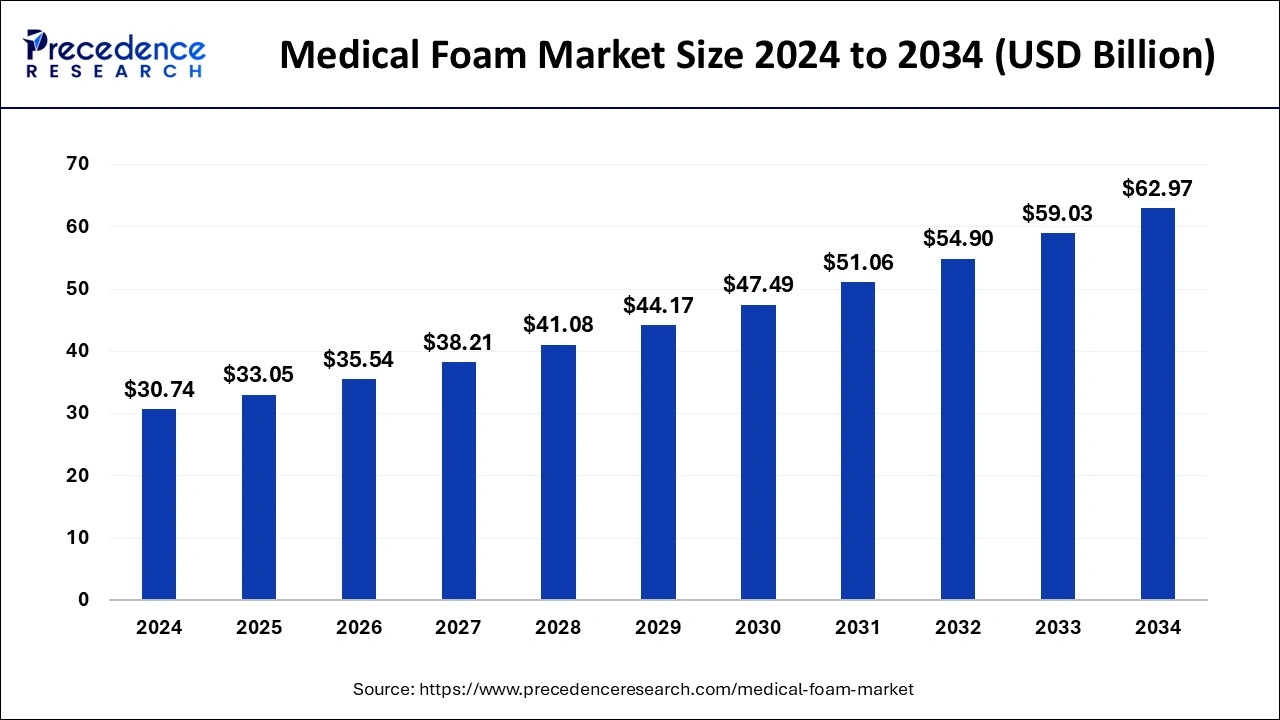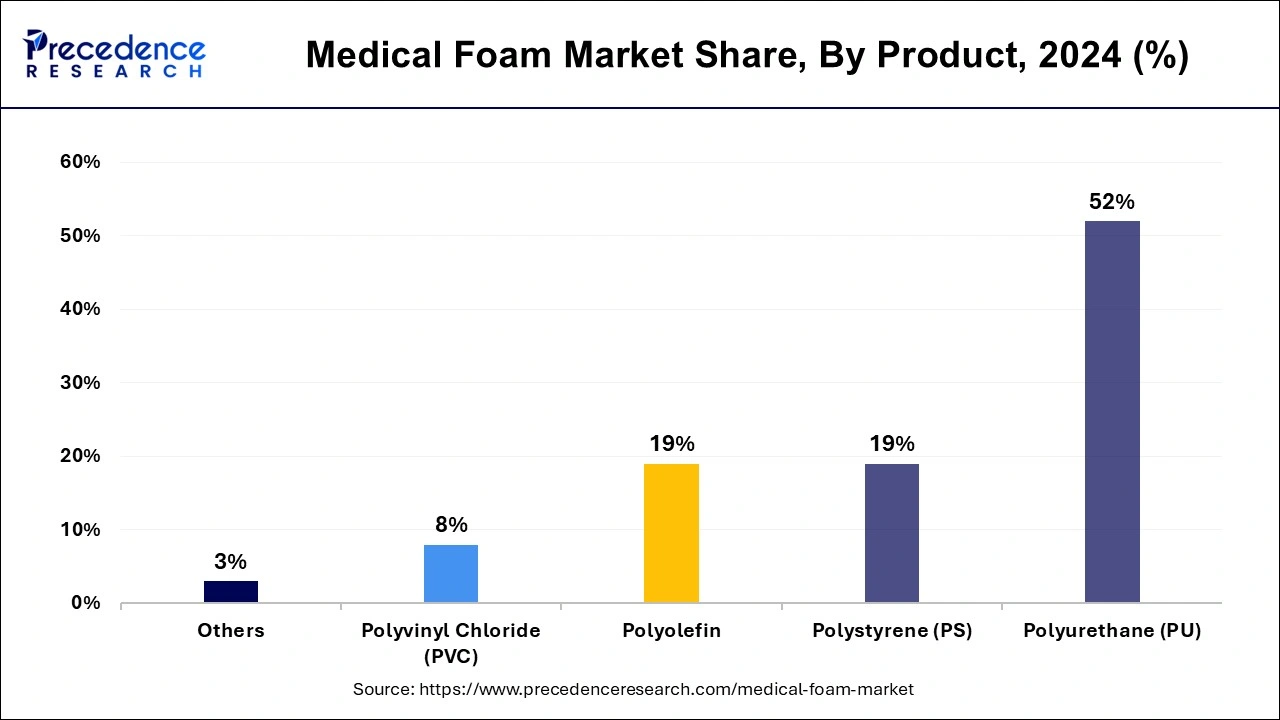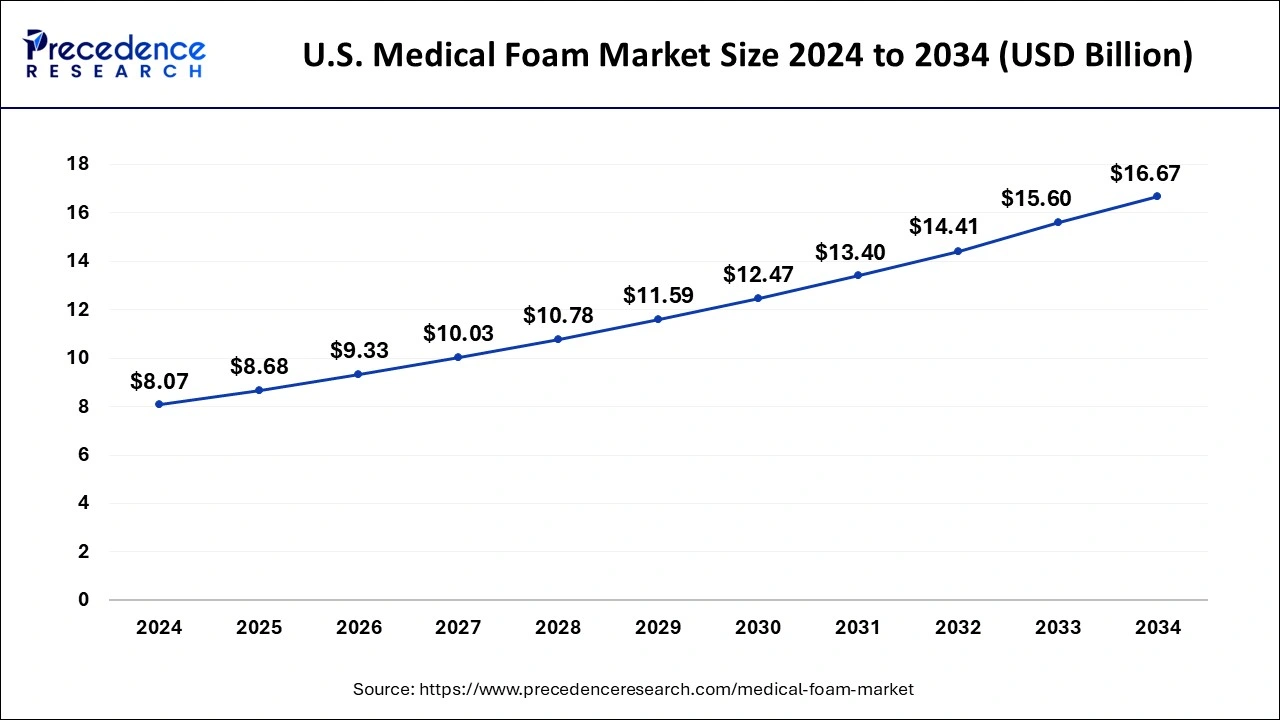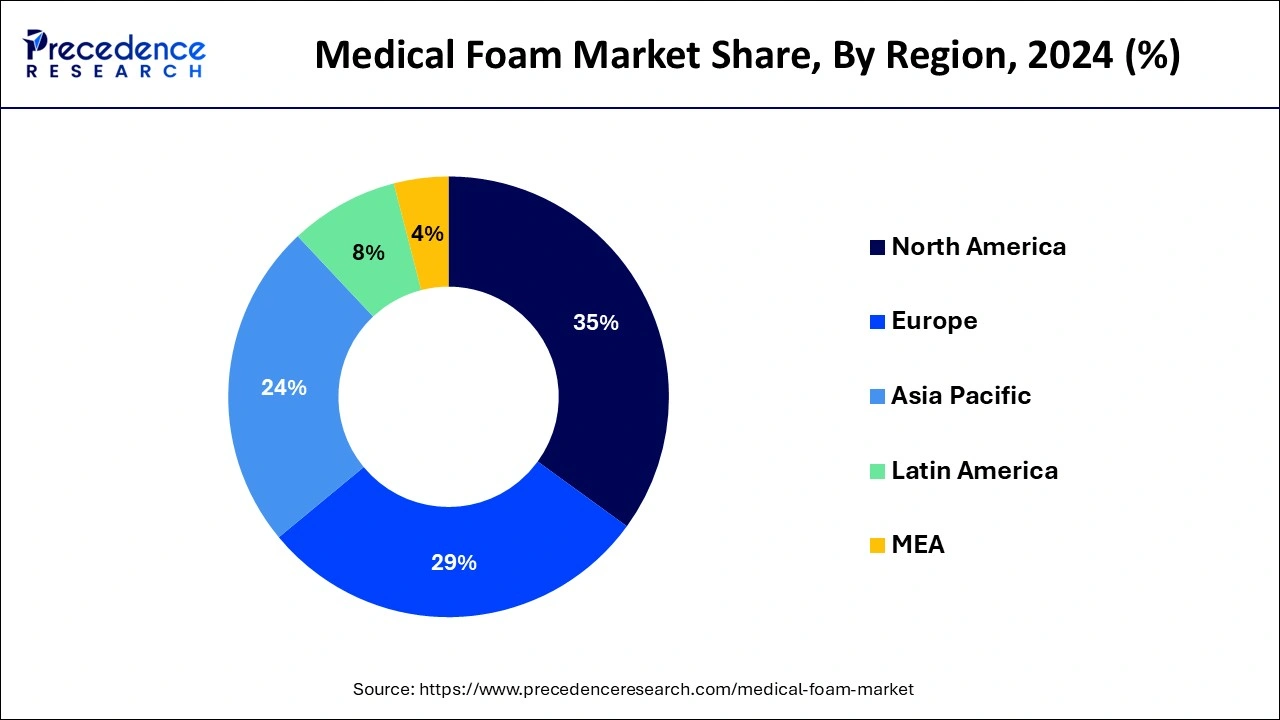List of Contents
What is Medical Foam Market Size?
The global medical foam market size is calculated at USD 33.05 billion in 2025 and is predicted to increase from USD 35.54 billion in 2026 to approximately USD 62.97 billion by 2034, expanding at a CAGR of 7.43% from 2025 to 2034. This growth is attributed to various factors, which include a rising geriatric population, an increase in global health expenditure, and the rapid expansion of themedical devices sector.

Market Highlights
- North America led the market with the largest market share of 35% in 2024.
- Asia Pacific is experiencing rapid growth in the market.
- By foam type, the flexible foam segment has held the major market share of 57% in 2024.
- By foam type, the spray segment is anticipated to grow at the fastest rate over the forecast period.
- By product, the polyurethane segment accounted for the maximum market share of 52% in 2024.
- By product, the polyolefin segment is projected to be the fastest-growing segment during the projected period.
- By application, the bedding & cushioning segment has held the biggest market share of 40% the market in 2023.
- By application, the medical devices & components segment is expected to grow at the fastest rate over the studied period.
Market Overview
Medical foam serves various medical purposes, like orthopedics, prosthetics, wound care, surgery, and patient positioning. It's crafted from materials like polyurethane, silicone, or latex and is tailored to have specific traits such as flexibility, resilience, and antimicrobial properties. It is found in wound dressings to shield, absorb fluids, and aid healing, as well as in orthopedic devices like splints and braces for support and immobilization of injured limbs. Medical foam is additionally utilized in crafting prosthetic limbs to establish comfortable and personalized connections between artificial and residual limbs. In surgical settings, it's used for padding during patient positioning, cushioning on operating tables, and managing bleeding. Moreover, there are ongoing developments in foam-based drug delivery systems for administering medications externally or internally.
Medical Foam Market Growth Factors
- The rising demand for advanced wound care solutions can drive the growth of the medical foam market.
- Increasing applications of medical foam in medical devices is likely to fuel the growth of the medical foam market during the forecast period.
- Technological advancements and innovations in materials can soon boost market growth.
- Growing expenditure on healthcare along with infrastructure developments can contribute to the expansion of the medical foam market.
- Sustainability and eco-friendly practices like water-based foaming agents can help in the medical foam market expansion.
Medical Foams Market Outlook
- Industry Growth Overview: Between 2025 and 2030, this market is expected to rise significantly due to the rising government initiatives aimed at developing the healthcare sector coupled with technological advancements in medical packaging.
- Major Investors: Numerous market players are actively entering this market, drawn by collaborations, R&D and business expansions. Various foam manufacturers such as Huntsman International LLC., Sekisui Chemical Co., Ltd., UFP Technologies, Inc and some others have started investing rapidly for developing high-quality foams to cater the needs of the healthcare sector.
- Startup Ecosystem: Several startup companies are engaged in manufacturing foams for the medical sector. The prominent startup brands dealing in medical foams consists of Porex, Biochange, Fibroheal and some others.
Market Scope
| Report Coverage | Details |
| Market Size in 2025 | USD 33.05 Billion |
| Market Size in 2026 | USD 35.54 Billion |
| Market Size by 2034 | USD 62.97 Billion |
| Growth Rate from 2025 to 2034 | CAGR of 7.43% |
| Largest Market | North America |
| Base Year | 2024 |
| Forecast Period | 2025 to 2034 |
| Segments Covered | Foam Type, Product, and Application |
| Regions Covered | North America, Europe, Asia-Pacific, Latin America, and Middle East & Africa |
Market Dynamics
Drivers
Growing demand for medical-grade foams in dressing and cushioning applications
Medical-grade foams are extensively used in the healthcare industry for various applications such as wound dressings, medical supports, and braces. These foams are valued for their softness, durability, flexibility, and lightweight and water resistance properties, which makes them ideal for protective packaging. They're also employed in customized orthotics, prosthetic padding, and ostomy sealing equipment. In medical breathing devices, they serve as heat and moisture exchange materials, while in wound care, they aid in healing and scar prevention. Commonly used types include polyethylene and cross-linked polyethylene for equipment protection and polyurethane and Metallocene foams for other medical applications.
- In September 2023, Infection prevention products manufacturer Tristel sought regulatory approval for its Tristel ULT hand-applied high-level disinfectant foam as a Class II medical device for endo-cavity ultrasound probes and skin surface transducers. The company has submitted the Tristel ULT application to Health Canada and expects a decision early next year.
Restraint
Stringent regulations associated with foam manufacturing processes
A significant challenge for the medical foam market is the strict regulations governing the manufacturing of foam. Making and using medical foam requires meeting rigorous quality standards and regulatory rules to ensure patient safety and product reliability. This can be tough for manufacturers, who must invest in advanced technology, quality control, and extensive testing, which leads to higher production costs and makes it harder for smaller companies to enter the market.
Opportunities
Rising use of medical foam in spinal implants
The use of medical foam in medical devices and components is on the rise due to increasing demand. Medical foam offers better biocompatibility and is cost-effective compared to other options. Furthermore, the growing emphasis on health and hygiene among consumers is boosting market growth. Global population growth is also driving up demand for medical foam. Moreover, medical foam is increasingly being used in spinal implants due to its strength, biocompatibility, and performance. These implants are designed to mimic cancellous bone by providing interconnected porosity throughout the implant. This increased usage of spinal implants will shortly propel the medical foam market growth.
- In December 2023, Surgical implant maker Xenco launched the injection-molded titanium foam implant that comes pre-attached to a disposable delivery device. It is Optimized for energy absorption and bone in-growth. The interconnected network of pores that permeate each CancelleX porous titanium implant serves to achieve bone-like mechanical properties.
Segment Insights
Foam Type Insights
The flexible foam segment dominated the medical foam market in 2023. The growth of the flexible foam segment is driven by its increasing use in cushioning, wound dressing, bedding, and medical packaging. Flexible medical foam possesses qualities suitable for various applications. Particularly, the demand for spray foam type is expected to surge due to its usage in prosthetics and wound care, like instant bandages. Spray foams are also widely employed in medical devices and packaging applications for coatings, filling, insulation, and sealing, which can further fuel segment growth.
In the medical foam market, the spray segment is anticipated to grow at the fastest rate over the forecast period. The flexible foam segment is growing because of its expanding role in prosthetics, wound care like instant bandages, and as coatings, fillers, insulators, and air seals in medical devices and packaging. This usage trend is expected to continue driving segment growth in the future.
- In January 2024, Holcim Building Envelope announces the launch of Enverge, an innovative, sustainability-focused spray foam insulation brand with a mission of changing the way the world insulates, creating more energy-efficient buildings and healthier living environments.
Product Insights
The polyurethane segment dominated the medical foam market in 2023. The segment is set to grow because of its broad range of uses in bedding, cushioning packaging, prosthetics, and wound care. Additionally, the application of rigid medical foams in podiatric, orthotics, wheelchair pads, hip protector pads, and hygienic seating for support and protection is expected to drive further growth in this segment during the forecast period
- In June 2022, Mitsui Chemicals and Microwave Chemical launched a new initiative aimed at commercializing chemical recycling of flexible polyurethane (PU) foam via microwave technology. The project involves the direct synthesis of PU raw materials by decomposing offcuts of the foam used to manufacture mattresses and similar items.

The polyolefin segment is projected to be the fastest-growing segment in the medical foam market during the projected period. The market is primarily growing because more people prefer flexible packaging over rigid packaging. Flexible foam is also easy to make and can support heavy loads, which helps companies save money on packaging by using less material.
Application Insights
The bedding & cushioning segment dominated the medical foam market in 2023. Medical foam used for bedding and cushioning is commonly found in hospitals, clinics, and home healthcare setups. It provides great support, helps distribute pressure, and ensures comfort, which is crucial for improving patient care and recovery. These foam solutions are used in mattresses, pillows, wheelchair cushions, and similar products to give maximum comfort and reduce the chances of pressure ulcers.
In the medical foam market, the medical devices & components segment is expected to grow at the fastest rate over the studied period. Medical foam is becoming more popular in medical device production due to growing demand. It's favored for its good biocompatibility and cost-effectiveness. Manufacturers often blend various plastics like polystyrene (PS) and polyethylene to create medical foam with the desired properties for use in these devices.
Regional Insights
U.S.Medical Foam Market Size and Growth 2025 to 2034
The U.S. medical foam market size is exhibited at USD 8.68 billion in 2025 and is projected to be worth around USD 16.67 billion by 2034, growing at a CAGR of 7.52% from 2025 to 2034.

North America dominated the medical foam market in 2024. The demand for medical equipment is expected to soar in the coming years due to increased healthcare spending per person in the U.S. This is likely to lead to a higher demand for medical foam in the region. One of the main factors influencing the North American market is the rise in healthcare spending per person in the United States, mainly through health insurance. Also, the increasing healthcare spending per person through health insurance in the U.S. has been a significant trend affecting the North American market.

Asia Pacific is experiencing rapid growth in the medical foam market, driven by increased awareness, higher disposable income, and improved access to healthcare services. With large populations, especially in countries like China and India, there's a growing demand for better medical solutions, including medical foam. Additionally, infrastructure development, supportive government policies, and increased investments in healthcare are further driving the growth of the medical foam market in the region.
- In October 2023, 3D printing companies EOS, Arkema, General Lattice, and DyeMansion collectively developed the Digital Foam Architects network. Featuring digital foam applications, this joint effort seeks to hasten the creation and additive manufacturing (AM) of consumer, medical, and industrial products. Digital Foam applications can be designed and produced with tailored features for performance, protection, and lightweight.
Why Europe held a significant share of the industry?
Europe held a significant share of the market. The rise in number of government hospitals in numerous countries such as Germany, Italy, UK, France and some others has boosted the market expansion. Also, the presence of various market players coupled with technological advancements in the foam manufacturing sector is expected to boost the growth of the medical foam market in this region.
What made Latin America to hold a considerable share of the market?
Latin America held a considerable share of the industry. The increasing sales of polyvinyl chloride (PVC)-based foams in the healthcare sector in various nations including Argentina, Brazil, Venezuela and some others has driven the market growth. Also, numerous government initiatives aimed at developing the healthcare sector is expected to propel the growth of the medical foam market in this region.
How did Middle East and Africa held a notable share of the industry?
Middle East and Africa held a notable share of the market. The rising use of flexible foams in private hospitals across numerous nations such as UAE, Saudi Arabia, South Africa and some others has boosted the market growth. Also, rapid investment by market players for opening up new foam manufacturing sector is expected to foster the growth of the medical foam market in this region.
Medical Foam Market Value Chain Analysis
- Raw Material Procurement :The main raw materials used for production of medical foams numerous substances including polyols and polyisocyanates.
Key Companies: Covestro, BASF SE, Dow Inc. and others. - Testing and Quality Control:Testing and Quality Control (QC) of medical foams are rigorous processes designed to ensure the materials are safe, effective, and consistent with specific regulatory and performance standards. These processes are critical because medical foams are used in sensitive applications such as wound dressings, surgical tools, and patient cushioning.
Key Companies: Poly Medicure, Lotus Surgicals, GE Healthcare and some others. - Distribution Channel : The distribution channels for medical foams are direct sales, distributors, online channels, and retail pharmacies. Medical foams are distributed to various end-users, including hospitals, clinics, ambulatory surgery centers.
Key Companies: Netmeds, Amazon, Alibaba and others.
Key Players in Medical Foam Market and Their Offerings
- Huntsman International LLC.: Huntsman International LLC is the chemical manufacturing company is a global producer and marketer of differentiated and specialty chemicals used in a wide range of consumer and industrial applications. These chemicals are used in a wide variety of sectors including aerospace, automotive, construction, coatings, healthcare, electronics, and footwear.
- Sekisui Chemical Co., Ltd.: Sekisui Chemical Co., Ltd. is a Japanese specialty chemical company that develops, manufactures, and markets a wide range of products, including high-performance plastics, housing and building materials, and urban infrastructure and environmental products. This company has a diverse portfolio that serves industries such as electronics, automotive, and healthcare.
- UFP Technologies, Inc.: UFP Technologies, Inc. is a US-based designer and manufacturer of custom-engineered components, products, and specialty packaging for the medical, automotive, aerospace, defense, electronics, consumer, and industrial markets. This company works with various materials such as foams, plastics, composites, and natural fibers, and its capabilities include design and engineering, molded fiber manufacturing, and thermoforming.
- Zotefoams plc: Zotefoams plc is a UK-based cellular material technology company specializing in the manufacture and sale of lightweight polymer foams and the licensing of its proprietary technology. It serves a wide range of global industries such as automotive, aerospace, medical, and sports.
- Avery Dennison Corp.: Avery Dennison Corporation is a global materials science and digital identification solutions company headquartered in Glendale, California. This company serves a wide range of industries such as retail, apparel, automotive, and healthcare.
- Rogers Corp.: Rogers Corp is a global technology leader that designs, develops, and manufactures engineered materials and components. This company manufactures a wide range of materials, such as laminated and printable materials, foams, ceramic substrates, silicone products, and RF laminates
- Foamtec Medical: Foamtec Medical is a custom medical device manufacturer specializing in the design and production of high-performance medical-grade polyurethane foam solutions. It manufactures a wide range of foams used for numerous medical applications including diagnostics, respiratory, orthopedic, and wound care.
Recent Developments
- In November 2025, Myze launched a new range of foams. These foams are designed for eyecare applications in different parts of the world.
(Source: https://glance.eyesoneyecare.com) - In September 2025, Derila Ergo launched a new foam-based pillow. This pillow is designed for improving sleep in patients.
(Source: https://www.globenewswire.com) - In February 2025, Glenmark launched Clindamycin Phosphate Foam. These foams find numerous applications in the healthcare sector.
(Source: https://www.expresspharma.in) - In December 2023, Roflumilast topical foam 0.3% received approval from the U.S. Food & Drug Administration (FDA) for the treatment of Seborrheic Dermatitis in those aged nine years or older.
- In June 2023, according to research at the University of Bath, Graphene-like foam sensors from stirlingshire-based integrated graphene can detect lactate concentrations for medical and fitness applications.
- In May 2023, diagnostic imaging equipment provider Probo Medical concluded the acquisition of the magnetic resonance imaging (MRI) coil repair operation from U.S.-based Creative Foam.
Segments Covered in the Report
By Foam Type
- Flexible Foam
- Rigid Foam
- Spray Foam
By Product
- Polyurethane (PU)
- Polystyrene (PS)
- Polyolefin
- Polyvinyl Chloride (PVC)
- Others
By Application
- Bedding & Cushioning
- Medical Packaging
- Medical Devices & Components
- Prosthetics & Wound Care
- Others
By Region
- North America
- Asia Pacific
- Europe
- Latin America
- Middle East & Africa
For inquiries regarding discounts, bulk purchases, or customization requests, please contact us at sales@precedenceresearch.com
Frequently Asked Questions
Tags
Ask For Sample
No cookie-cutter, only authentic analysis – take the 1st step to become a Precedence Research client



